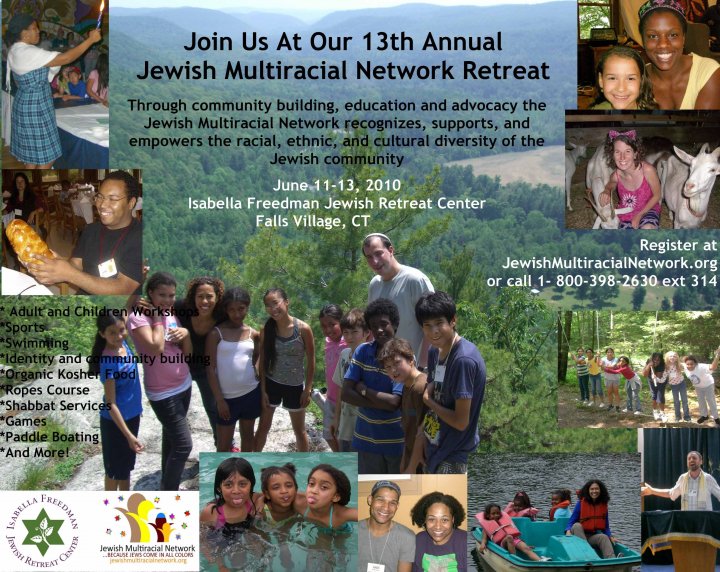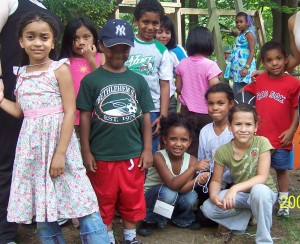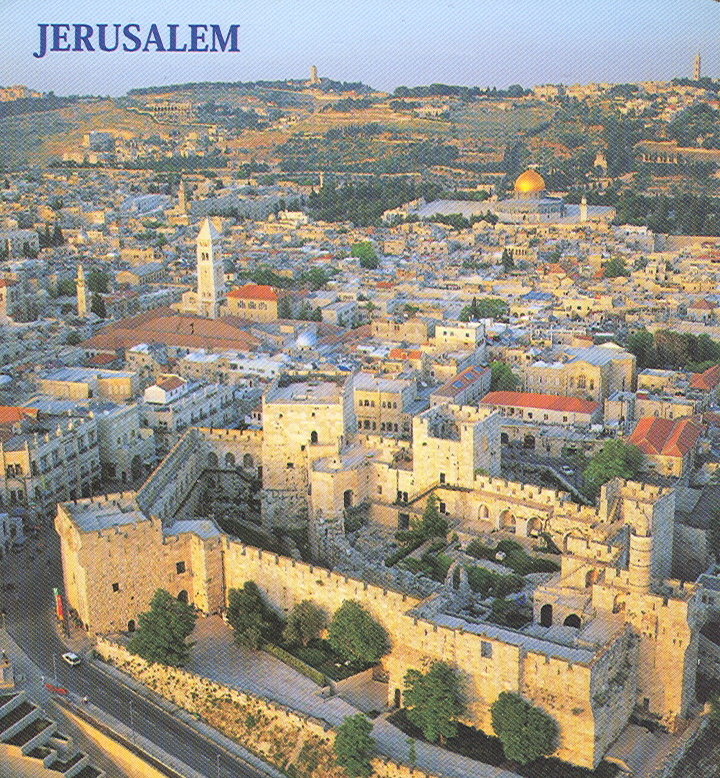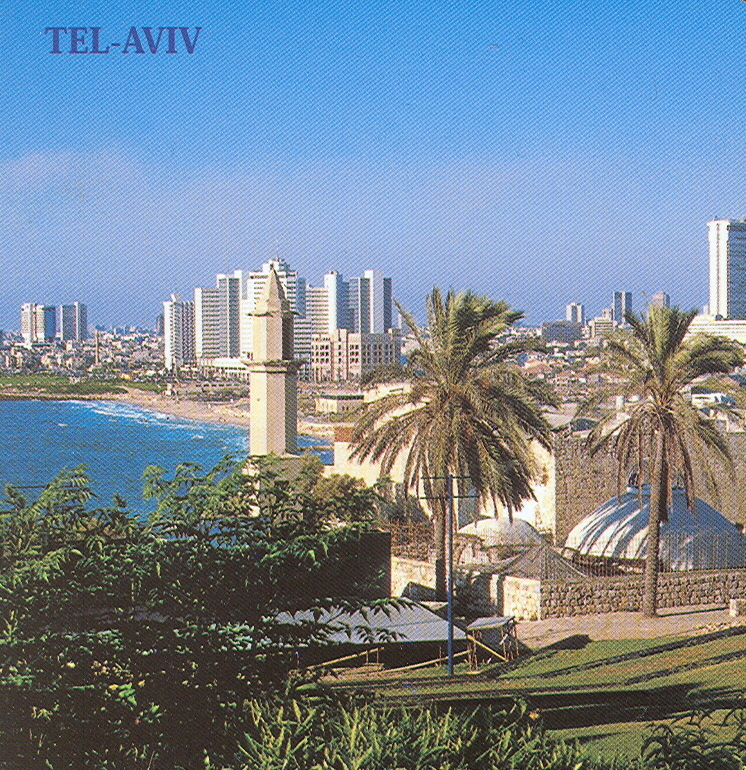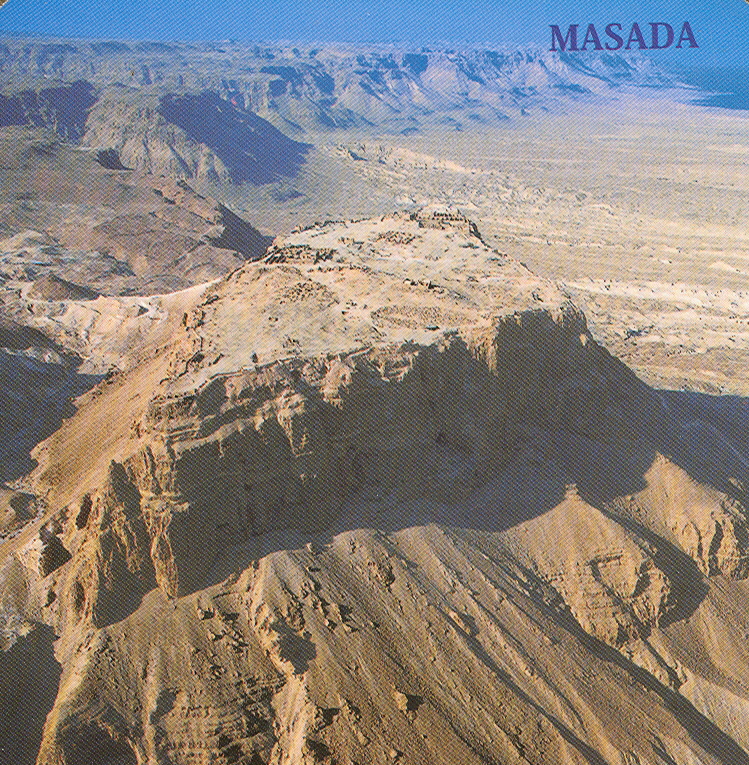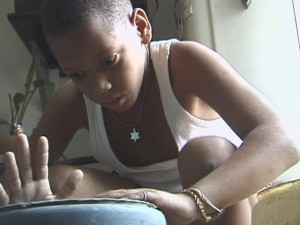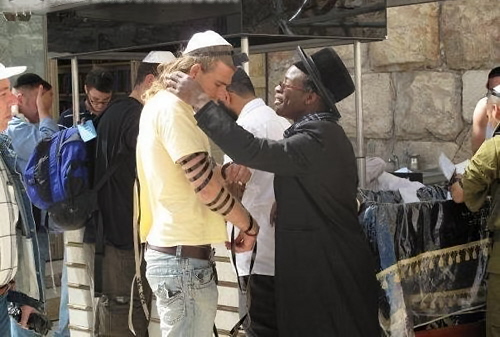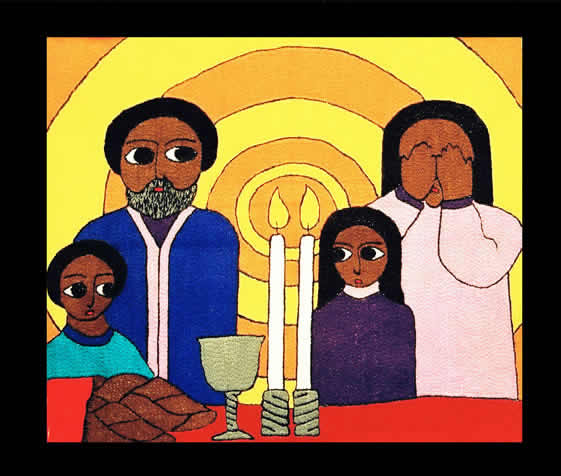Enlightenment
Jewish Multiracial Network Thirteenth Annual Retreat: June 11 – 13, 2010
Join dozens of other Jewish multiracial families and Jews of Color of all ages for an inclusive Shabbat experience that will celebrate the diversity of our community. The weekend includes exciting adult discussions and workshops, youth and teen programming, childcare, multi-generational family programming and time to relax and enjoy all that the Isabella Freedman Jewish Retreat Center and JMN have to offer.
Ashkenazi and/or White Jewish Privilege Checklist
I can walk into my temple and feel that others do not see me as outsider.
I can walk into my temple and feel that others do not see me as exotic.
I can walk into my temple and feel that my children are seen as Jewish.
I can walk into my temple with my family and not worry that they will be treated unkindly because of the color of their skin.
I can enjoy music at my temple that reflects the tunes, prayers, and cultural roots of my specific Jewish heritage.
No one at my synagogue will attempt to assign me to a ethnicity to which I do not belong (e.g., assuming all Jews of African descent are Igbo or Ethiopian).
I can easily find greeting cards and books with images of Jews who look like me.
I can easily find Jewish books and toys for my children with images of Jews that look like them.
I am not singled out to speak about and as a representative of an “exotic” Jewish subgroup.
When I go to Jewish bookstores or restaurants, I am not seen as an outsider.
I find my experiences and images like mine in Jewish newspapers and magazines.
I do not worry about access to housing or apartments in predominately Jewish neighborhoods.
My rabbi never questions that I am Jewish.
When I tell other members of my synagogue that I feel marginalized, they are immediately and appropriately responsive.
There are other children at the religious school who look like my child.
My child’s authenticity as a Jew is never questioned by adults or children based on his/her skin color.
People never look at me and say “But you don’t look Jewish” either seriously or as though it was funny.
I do not worry about being seen or treated as a member of the janitorial or administrative staff at a synagogue or when attending a Jewish event.
I am never asked “how” I am Jewish at Jewish dating events or on Jewish dating websites.
I can arrange to be in the company of Jews of my heritage most of the time.
When attempting to join a synagogue or Jewish organization, I am sure that my ethnic background will not be held against me.
I can ask synagogues and Jewish organizations to include images and cultural traditions from my background without being seen as a nuisance.
I can enroll in a Jewish day school, Yeshiva, and/or historically Jewish college and find Jewish students and professors with my racial or ethnic background.
People of color do not question why I am Jewish.
I know my racial or ethnic background will not be held against me if I attempt to join a minyan in prayer.
I know my ethnic background will not be held against me in being called to read the Torah.
I am not discriminated against in the aliyah process as a Jew of my particular ethnicity.
Text not copyrighted. Developed for educational purposes by the Jewish Multiracial Network, 2006–2009. Please distribute and add to the checklist.

“Jewish life will be fine with all sorts of communities and groupings with all sorts of people -Jews and non-Jews- being Jewish, using Jewish wisdom and practice, in many ways that we can not even imagine.” ~ Irwin Kula, Renowned Thinker, Teacher, Author & Rabbi
These Are My Names
Ethiopian Jews’ multiple names reflect the richness, wisdom and beauty of their culture — and every name tells a story. In the film, young Ethiopian Israelis share their journeys toward their names: stories of love and connection, survival and loss, anger and pride. The characters’ original names – changed without their consent upon arrival in Israel – take them back to their childhoods in mountain villages, to the hunger and fear in Sudan, to longing for loved ones who died or disappeared on the journey to Israel, to denial of their identity…and reclamation of their roots.
Black Over White
The concert in Addis Ababa is not just another performance by the Idan Raichel Project, but a journey back to the homeland of two of the Project’s lead singers, Cabra Casay and Avi Vograss Vesa.
The film raises questions about identity and seeks to reawaken the pain of immigration, which is still there even after so many years, rekindling the authenticity and bond to the place that will exist forever in their minds and hearts.
Caravan 841
Moshe, an 11 year-old Ethipian boy, lives in dwindling “Atidim” caravan site in the Wester Galilee and is awaiting the arrival of his mother from Ethiopia. She will not arrive and he is torn between Aharon, a 60-year-old repentant Jew who teaches him Torah, and Walter – an impulsive African American saxsophone player who has a jazz club at the edge of the site. Aharon gives Moshe a magic box and promises him that it will bring his mother to Israel. Walter gives Moshe the strength to believe only in himself.
The Name My Mother Gave Me
“The Name My Mother Gave Me” is a film about growth and self discovery. We follow Ethiopian and Russian Israelis who meet at a leadership training program in Israel. Their year of learning culminates in a journey to Ethiopia where the Ethiopian born participants return to their native villages and confront their roots. Though, back home in Israel, all the participants would consider themselves members of the fringes of Israeli society, in the highlands of the Ethiopian landscape they discover the universality of their experiences and their shared commitment to their new home in Israel. How will this journey transform them?
I Had a Dream
As a young boy, born into a closed and isolated community in Ethiopia, far from the centers of the Jewish world, Yona Bugale was brought to Europe, where he discovered his common heritage with the Jewish people. Yona Bugale himself did not live to see the realization of his dream and life’s work, yet he worked ceaselessly as a teacher and community leader, promoting connections with the State of Israel and with Jewish organizations, in order to prevent the possible destruction of Ethiopian Jewry.
Based on rare archival material, the film’s aim is to expose and preserve not only an extraordinary life story, but also, to give expression to the complexity of the Ethiopian aliyah and of their absorption in Israel .
All movies and documentaries can be purchased at: Ruth Diskin Films:
Ruth Diskin Films continues to offer a wide, in depth view, of one of the most compelling places on earth – a kaleidoscope of Israeli society, as well as films with strong Jewish content, made by leading documentary filmmakers world-wide.
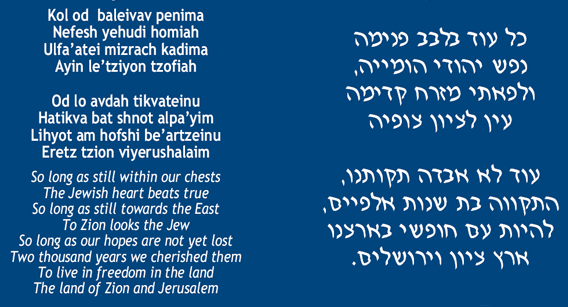
Hatikva initiative is seeking to unite the Jewish people and strengthen the ties between all Jews, whoever and wherever they are, thereby strengthening Herzl’s vision. The mission of Live Hatikva is to bridge gaps of language and distance between the Jewish people by celebrating together, in real time. The Hatikva initiative was launched by Galia Albin, with the aims of encouraging Schools, synagogues, youth groups, friends, families and individuals young and old around the world to learn the words and significance of the anthem, thus strengthening their connection with Israel and the Jewish people.
Hatikva Initiative 2010: From South America in Brazil, Argentina, Costa Rica, Bolivia, Columbia and Peru. With Hillel: The Foundation for Jewish Campus Life (www.hillel.org) If you wish to be part of the broadcast contact: galia@almedia.co.il.
![]()
MOROCCO – THE MUSIC OF THE JEWS OF MOROCCO
YEMEN – THE MUSIC OF THE YEMENITE JEWS
In 1948 nearly one million Jews lived in Arab lands. But In barely twenty years, they have become forgotten fugitives, expelled from their native lands, forgotten by history and where the victims themselves have hidden their fate under a cloak of silence.A people whom legend have always associated with “wandering” many of these Jews from Arab lands had lived there for thousands of years and accepted their fate, through good times and bad times.
The Silent Exodus by Pierre Rehov. Purchase documentary HERE
Personal stories of life as dhimmi (outsiders) in the Middle East and North Africa
The Forgotten Refugees, a film about the Mass Exodus of Millions of North African and Middle Eastern Jews
| About the Award-Winning Documentary Film & Educational Portal |

The Forgotten Refugees explores the history and destruction of Middle Eastern Jewish communities, some of which had existed for over 2,500 years. It chronicles the impact of the Arab Muslim conquest, the development of Judeo-Arab culture, and the modern rise of Arab nationalism that drove out hundreds of thousands of Jews from their homes and communities. This destruction is a significant loss for the Jewish people and for the Middle East.
Featuring testimony from Jews who fled Egypt, Libya, Iraq, Yemen, Morocco and Iran, the film explores the rich heritage and destruction of the Middle East’s age-old Jewish communities. Personal stories of refugees are interspersed with dramatic archival footage, including the mission to rescue Yemenite Jews.
The film represents a unique approach to educating the public about an integral but little known aspect of Middle East history.
Get a FREE copy of the Film. Email FR@davidproject.org or call (617) 428-0012 to get a complimentary copy of The Forgotten Refugees. Shipping & handling: $5.00
The Forgotten Refugees Official Website HERE
 Jewish Wedding in Morocco, Eugène Delacroix-Jüdische Hochzeit in Marokko 1837–41
Jewish Wedding in Morocco, Eugène Delacroix-Jüdische Hochzeit in Marokko 1837–41
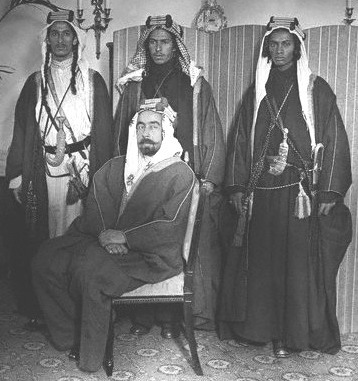
1922: King Abdulla Ibn Hussein of Transjordan sits under the watchful eyes of his Jewish bodyguards, Habanni Yemenite brothers Sayeed, Salaah, and Saadia Sofer.
The History of Abir Hebrew Warrior Arts HERE
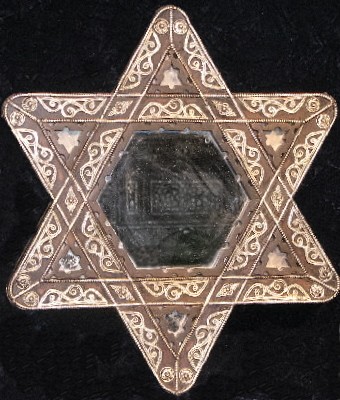 Star of David Mirror Handcrafted in Morocco
Star of David Mirror Handcrafted in Morocco
The Last Jews of Libya documents the final decades of a centuries-old Sephardic Jewish community through the lives of the remarkable Roumani family. Thirty-six thousand Jews lived in Libya at the end of World War II, but not a single one remains today.
The Flying Camel: Essays on Identity by Women of North African and Middle Eastern Jewish Heritage Edited by Loolwa Khazzoom
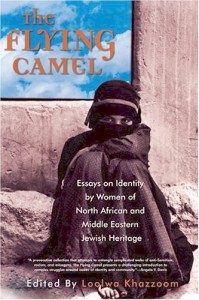 Many of us have stereotypes of what “Jewish” looks like—and for many of us that image is white and European. Yet, with the blossoming Jewish multiculturalism movement, led by the dynamic Loolwa Khazzoom, the myth of a “monolithic Jewish community” is about to be debunked. Focusing on the experiences of Jewish women of two rich and varied regions, The Flying Camel reveals the hidden worlds of Jewish women often misunderstood or maligned by both the cultures in which they live and the European-Jewish community.
Many of us have stereotypes of what “Jewish” looks like—and for many of us that image is white and European. Yet, with the blossoming Jewish multiculturalism movement, led by the dynamic Loolwa Khazzoom, the myth of a “monolithic Jewish community” is about to be debunked. Focusing on the experiences of Jewish women of two rich and varied regions, The Flying Camel reveals the hidden worlds of Jewish women often misunderstood or maligned by both the cultures in which they live and the European-Jewish community.
Book: The Farhud by Edwin Black
“TIMELY AND REVEALING, in the Farhud, Black has brought to the surface a topic that others would have purposely overlooked.” Shelomo Alfassa former U.S. Director of Justice for Jews from Arab Countries
Articles:
Jews displaced from Arab lands finally recognized
Persecuted Yemeni Jews to be given sanctuary in Britain
Jewish Exodus from Arab and Muslim Lands
Museum provides a history of Jews in Morocco
For additional information go to:
Distinguished Anthropologist Ruth Behar (recipient of the MacArthur Fellowship) returns to her native Cuba to profile the island’s remaining Sephardic Jews and chronicle her family’s journey to the U.S. as Cuban-Jewish exiles. Highlighting themes of expulsion and departure that are at the crux of the Sephardic legacy, Behar seeks reconciliation with Cubans on the island and advocates for the possibility of return and renewal. She debunks myths about the country’s Jewish community and unravels the influence of interfaith marriage, Afro-Cuban santería, tourism and the embargo on contemporary Cuban-Sephardic cultural identity. The result is a bittersweet, lyrical, and often humorous portrait of modern-day Cuba that few know exists today. Narrated by Elizabeth Peña. If you want to purchase this documentary go to the following link: Women Make Movies (films by and about women)
History Cuban Jewish Community 1890’S – 2009
Jews in Cuba (from the Encyclopedia Judaica)
“The first Jewish group to settle in Havana after Cuban independence (1902) came from the United States. They founded the United Hebrew Congregation in 1906. They were followed by Sephardim, mainly from Turkey, whose communal congregation, Shevet Ahim, was founded in 1914. In the 1920s thousands of Jews from Eastern Europe arrived in Cuba, hoping to use it as a stepping stone to the U.S. Many of them settled in Havana, where they founded the Centro Israelita (Jewish Center) in 1925, together with a large number of social, religious, cultural, and political organizations. In the late 1930s and during World War II Havana became a temporary haven for thousands of Jews fleeing Nazi Germany, using loopholes in Cuba’s immigration laws. In May 1939, however, Havana was the scene of the tragic episode of the S.S. *St. Louis, whose passengers were refused landing and were compelled to return to Europe, where many of them perished in extermination camps.
Following World War II the Havana community prospered both economically and socially. In 1951 the Ashkenazi community laid the cornerstone for the Patronato, a magnificent building that symbolized the social mobility and prosperity of Havana Jews. When the Sephardim inaugurated their Sephardi Center, Fidel Castro was already in power.
The Cuban revolution of 1959 marked the decline of Havana Jews. Following the nationalization of private business, around 90% of them emigrated from Cuba, most of them to the United States. The government respected the right of the Jewish community to continue its religious life, but the demographic decline, the emigration of lay and religious leaders, and the influence of the atheistic policy of the state had a growing impact on Jewish life. In 1973 Cuba severed its diplomatic relations with Israel, and the isolation of Havana Jews increased.”
For additional information on the Jews of Cuba see:
New Article! Cuba’s Dwindling Jewish Community Fighting For its Life
The Cuba-America Jewish Mission (The CAJM)
Cuba – The Virtual Jewish History Tour
B’nai B’rith International Cuban Jewish Relief Project
Mission to Cuba: The United Synagogue of Conservative Judaism, Southeast Region
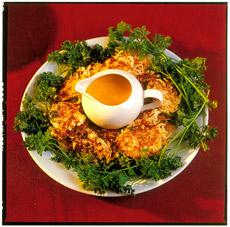 Frituras de Malanga
Frituras de Malanga
2 medium malanga or taro root, about 1 pound (available in Spanish markets)
1 small onion
1 teaspoon white or apple cider vinegar
1 1/2 teaspoons salt
1 egg
1 Tablespoon finely chopped parsley (optional in Cuba)
Freshly ground black pepper (optional in Cuba)
Vegetable oil for frying
1. Peel the malanga. Grate, using the finest grating disk on your processor. Grate the onion in the same way. Replace the grating disk with the steel blade and pulse on about 20 times until the pieces are quite small but not mushy. Transfer to a bowl. Alternatively, grate the malanga and onion on the fine side of a grater and place in a bowl.
2. Add the remaining ingredients except the oil and mix well.
3. Heat about 1 inch of oil in a frying pan until very hot, about 375°F.
4. Using a teaspoon, drop the mixture into the hot oil. Fry until golden on each side.
5. Drain on paper towels.
6. Serve with Mojo sauce, sour cream, apple sauce, or salsa. Yield: approximately 40 small fritters.
Mojo Sauce
The ubiquitous orange trees in Andalusia are not the sweet variety we associate with Valencia; they were probably brought to this region with the Spanish conquistadores. Sour orange juice is now a common ingredient in Cuba, confirming its roots in Spanish and possibly Jewish cooking (the first Spaniard to set foot on Cuba was a Jew–Columbus’ scout).
Mojo Sauce
1/4 cup olive oil
6 large cloves garlic, finely minced
1/2 cup sour orange juice or 1/4 cup orange juice and 1/4 cup lime juice
1/2 teaspoon ground cumin
Salt and freshly ground black pepper to taste
1. Heat a 1-quart saucepan for 15 seconds. Add the olive oil and heat for 10 seconds.
2. Add the garlic and cook for 20 seconds or until it just starts to get lightly golden. Do not let the garlic brown or the sauce will become bitter.
3. Add the remaining ingredients and bring to a rolling boil. Cook for three minutes.
4. Remove the sauce from the heat. Adjust the seasonings if necessary and chill until ready to serve with the fritters or on top of vegetables, meats, or fish. Yield: approximately 1 cup of sauce. Recipe courtesy of Reform Judaism Magazine
We Are Experiencing A New Global Judaism That Reflects Our True History & Emerging Future ~ Be’chol Lashon
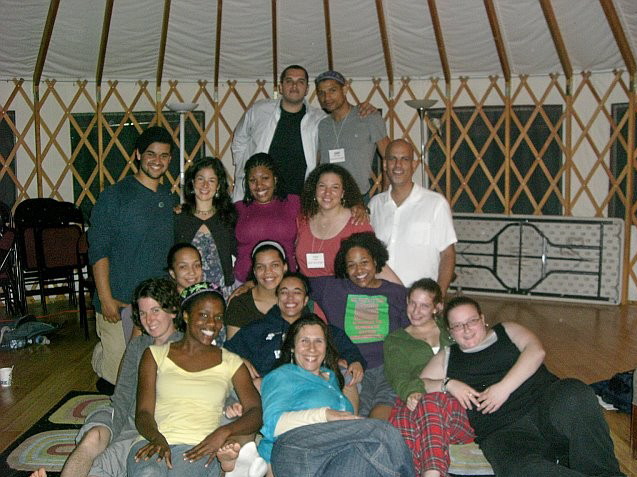 Directors, Counselors, & Workshop Facilitators at the Jewish Multiracial Network Retreat.
Directors, Counselors, & Workshop Facilitators at the Jewish Multiracial Network Retreat.

10 Tips Toward Racial & Cultural Sensitivity in the Jewish Community
1 ~ Reach out to other Jews across difference because you will find our commonalities exceed our differences by far.
2 ~ Do not assume that Jewish history and the current Jewish population is comprised most significantly of Jews of European culture ancestry.
3 ~ Consider that within the customs and traditions of the Jewish people, there is a great diversity of language, culture, custom and color. Be willing to reach for and stay connected to the diversity of the Jewish people.
4 ~ Do not assume that because a person has dark skin that they must be a convert. This is not necessarily true or fair to individuals that have been Jewish all of their lives.
5 ~ Learn to value the “inner” Jew in yourself so that you can better appreciate it in others.
6 ~ Get to know the customs and traditions of Jews from the Middle East and North Africa and welcome this knowledge as a necessary component of your Jewish education.
7 ~ If you find a person’s journey around difference to be inspiring, be it their color, background, abilities, culture, traditions, etc., try not to limit your praise of them to their being “inspiring”.Tell them what about them inspires you specifically.
8 ~ Remember that it’s o.k. to be curious, but to become fascinated with a person because of an aspect of their physicality ALONE, is to turn that person into an object in your regard. Make efforts to make your relationships with people who are different than you, more than skin deep.
9 ~ Keep in mind that Jews of Color have a lot to offer the Jewish community, both in experience and perspective and should be welcomed to participate in all levels of Jewish social interaction, including leadership.
10 ~ Remember that denial is not just a river in Egypt (smile), it can also be an obstacle toward finding lasting solutions. When we sit with the things inside us that make us the most uncomfortable, we often find deeper truth and growth on the other side. ~Courtesy of Ayecha
If I am not for myself, who will be for me?
If I am not for others, what am I?
And if not now, when?
~ Rabbi Hillel ~
Jewish Voices Of Color Must Be Heard by David Love
As we enter this holiday season, Jews around the world will celebrate Hanukah. And the global Jewish community is a diverse one, a multicultural and multiracial assemblage, by no means monolithic, representing millions of people throughout the world. Jews in China look like other Chinese, while Jews in India resemble other Indians, as is the case with the Igbo Jews of Nigeria and the Lemba of Southern Africa, and so on. They differ in their religious and cultural expression. For example, some may not know about glatt kosher, but still observe traditional dietary laws. And in some places only women can become a mohel (the person who performs circumcisions on baby boys).
But like a faulty census that leaves out people and portrays an inaccurate picture of what is happening, the Jewish Diaspora is not counting all of its members. Part of the reason is that Jews of color are often held in suspicion, not viewed as real or authentic. The reality is that black and brown Jews always existed, and for thousands of years. Given the places where the stories in the ancient scriptures took place, what else could you expect? Yet, media images – including Charlton Heston’s portrayal of a blond-haired, blue-eyed Moses in The Ten Commandments – only serve to create confusion concerning race and Judaism.
“Jews of color have been like Jerzy Kosinski’s The Painted Bird, a bird trying to reintegrate itself into its flock, but looks so different that the flock would turn itself on the painted bird, pecking on the painted bird until it falls to the ground,” said Rabbi Capers Funnye, head rabbi of the predominantly African-American Beth Shalom B’nai Zaken Ethiopian Hebrew Congregation in Chicago. The congregation was founded in 1918 by a rabbi from Bombay, India.
Rabbi Funnye converted to Judaism, but his introduction to Judaism was through the lens of Africa. His congregation combines the usual Jewish prayers with gospel music and the beat of the drum. But that is ok, because that is what culture is all about. “Jewish practices are based on cultural adaptations, where people found themselves,” the rabbi notes. Although he is a rabbi with extensive knowledge and undeniable passion, Rabbi Funnye is asked if he is really a Jew. “For a Jew who don’t look like you, that question is offensive,” he responds.
Rabbi Funnye – who is also a member of the Chicago Board of Rabbis, and the cousin of First Lady Michelle Obama – recently gave the keynote speech at a symposium on race and Judaism at Temple University. The symposium was convened by Professor Lewis Gordon of Temple’s Center for Afro-Jewish Studies, and had participation from the Institute for Jewish and Community Research and Be’chol Lashon, a San Francisco-based group which encourages ethnic, racial and cultural inclusion in the Jewish community.
The conference was refreshing in that it invited a discussion on subjects usually not covered in academia or the mainstream Jewish community. For example, there was a discussion on Rabbi Alysa Stanton, the first African-American woman ordained as a rabbi, and the first black rabbi to lead a majority white congregation. Stanton, whose congregation is in Greenville, NC, received death threats and required a police escort the day she was installed as rabbi.
Another topic of discussion was Rabbi Abraham Joshua Heschel, that mythic symbol of black-Jewish cooperation who marched with Dr. Martin Luther King. Rabbi Heschel is a great source of pride for the Jewish community, yet he was marginalized during his life, and regarded as an oddball. Other rabbis advised him to stay away from the rabble-rouser King. And today, Heschel’s anti-racist, social justice message is defanged.
Further, there was an examination of black-Jewish relations and the civil rights coalition, and the manner in which Jews benefited from civil rights in ways blacks could not; the focus by organizations such as the ADL on issues of Jewish authenticity and Minister Louis Farrakhan, when there are genocides taking place around the world; concepts of whiteness and blackness, and the ways in which the Jewish communities have negotiated race. Participants also tackled such weighty issues as black power, and the attempts to equate it with anti-Semitism; the disproportionate representation of neoconservative Jewish voices in American political discourse, and the use of white Ashkenazi Jewish voices as the authoritative voice against affirmative action.
Included in the symposium was the inevitable discussion of Israel, and the ways in which some immigrants become “white” when they arrive in Israel, although they were not considered as such in their home countries. And of course, there is Israel’s occupation of Palestine. Rabbi Funnye, who works with the Palestinian-American community in Chicago, believes that Israel must do a better job of showing its own diversity. He also shed some light on African-American perceptions of the Israeli-Palestinian conflict. “Black people don’t say anything because they see the Palestinians as David, and Israel as Goliath,” Funnye concluded. “They don’t want to be called anti-Semites.”
These are tough issues, to be sure, and the conversations must continue at Temple University and throughout the country and the world. A culture benefits when its diverse voices are allowed to express themselves. This is how a culture sustains itself and grows. Jews of color have much to contribute, and much to say. And they must be heard.
BlackCommentator.com Editorial Board member David A. Love, JD is a journalist and human rights advocate based in Philadelphia, and a contributor to the Huffington Post, theGrio, the Progressive Media Project and McClatchy-Tribune News Service, among others. He contributed to the book, States of Confinement: Policing, Detention, and Prisons (St. Martin’s Press, 2000). Love is a former Amnesty International UK spokesperson. His blog is davidalove.com.This article first appeared in The Black Commentator and is republished with permission.
span style=”color: #c0c0c0;”>![]()
![]()
The song “Memories of Africa – Zichronot me Africa” performed by the Sheba Choir and composed by Shlomo Gronich
![]()
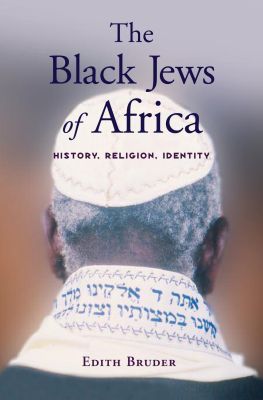 Amazon Reveiw by Michael Ophir: The Black Jews of Africa by Edith Bruder is an interesting, well written book. The author goes to great lengths to educate the reader as to the origins and whereabouts of various Jewish or Judaic communities across the African continent.
Amazon Reveiw by Michael Ophir: The Black Jews of Africa by Edith Bruder is an interesting, well written book. The author goes to great lengths to educate the reader as to the origins and whereabouts of various Jewish or Judaic communities across the African continent.
However, what should be noted in several instances, the author insinuates that many Jewish communities are not actually Jewish. For instance, she refers to the Jews of Ethiopia as the “so-called” Jews of Ethiopia. Why are they “so-called”?. Even if they are not descendants of the Hebrews, if they practice Judaism, they are Jews. Why do people not refer to Russian Jews as “so-called” Jews of Russia? After all, many Russian Jews today have much weaker links to Judaism than the Jews of Ethiopia.
Besides this disturbing point, the book is informative and a must read for any interested in this topic. The emergence and in some cases re-emergence of Judaism and Jewish communities in various parts of Africa is a movement that is gaining momentum as people on the continent discover the religion and their roots. A must-read for all interested in Jewish/African or African-Jewish topics.
![]()
Enjoy a memorable Shabbat experience! Join Riki Mulu and Chassida Shmella, a vibrant community founded by a new generation of Ethiopian-Israeli Jews in America, to celebrate the Sabbath with unique Ethiopian customs. Special guest will be Dr. Ephraim Isaac, director of the Institute of Semitic Studies in Princeton, NJ. Families are welcome. Space is limited; pre-registration required. Co-sponsored with Chassida Shmella and with Bechol Lashon.
Ethiopian Shabbat Dinner (JCC Manhattan)
Fri, Dec 4
6:00 PM – 9:00 PM
Dr. Ephraim Isaac, Ethiopian Yemenite Jewish scholar extraordinaire, linguist, conductor, historian and history maker, Director of the Institute of Semitic Studies in Princeton, NJ.
![]()
Bizu “Riki” Mullu, a jewelry artist and community activist, works with Chassida- Shmella, one of two U.S.-based organizations to provide Ethiopian Jews with cross-cultural networks, communal partnerships and educational/professional opportunities
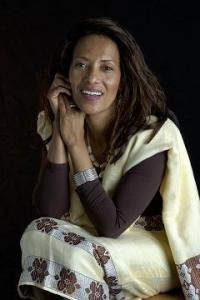
Riki Mullu’s Doro Wat (Ethiopian Chicken Stew)

1 whole chicken cut into 12 pieces
1/4 cup olive oil
2 yellow onions (finely chopped)
1 red onion (finely chopped)
3 cloves garlic
1 Tbsp fresh ginger
3/4 cup tomato paste
2 Tbsp chili powder
2 Tbsp flaxseed (available at health food stores)
5 hard-boiled eggs peeled and scored lightly (1 per person or as needed )
1/2 tsp turmeric
1/2 tsp ground coriander
1/2 tsp ground fenugreek
1/4 tsp fresh ground black pepper
1 tsp ground cardamom
Cook onions in oil for ten minutes until soft. Add tomato paste and chili powder and spices and cook another ten minutes or more until flavors blend. Add chicken and about one cup water. Simmer for about 45 minutes until chicken is thoroughly cooked. Add hard boiled eggs. Grind fresh garlic and ginger together. Grind one Tbsp flax seed oil. Add to chicken. Cook for about 2 more minutes.
Hadassah Magazine Extra
November 2009
Elinor Ruth Tatum
By Charley J. Levine

‘When two cultures don’t know each other, there are preconceived notions that must be dispelled,’ says Tatum, ‘and that comes only through education.’
As publisher and editor in chief of Harlem-based New York Amsterdam News, the city’s leading African-American newspaper, Elinor Ruth Tatum is one of the highest profile Jewish black women in the country. Tatum, 38, also produces and cohosts a segment of Al Sharpton’s radio show, Keepin It Real, which discusses national issues facing the black community. With degrees in government and international affairs as well as journalism and mass communication, Tatum is a leader in community affairs organizations, serving on the boards of humanitarian, museum and educational associations. Her dual heritage makes her ideally suited to bring together the Jewish and black communities.
Courtesy of Elinor Ruth Tatum
Q. Your father, Wilbert Tatum, the longtime publisher and editor of the Amsterdam News, was a legend, though he roiled the racial waters by criticizing Jewish leaders and organizations, especially during the 1991 Crown Heights riots. What legacy did your father leave you?
A. Because of [his outspokenness and passion], at times he lost friends. But he stood by his beliefs, no matter what. People would come around, sometimes years later, and say, ‘Maybe you weren’t wrong, Tatum.’ We have a responsibility as journalists to the greater world to defend what’s good and call out what is bad.
Q. Not so long ago, the tenor of black-Jewish relations seemed to be set back by people like Louis Farrakhan, Jesse Jackson and Al Sharpton. Are we beyond the crisis point?
A. I don’t know if the situation was ever really as bad as some thought. Many issues between blacks and Jews were created more by the media than anyone else. Basically there were two peoples who did not know the other very well. When two cultures don’t know each other, there are preconceived notions that must be dispelled, and that comes only through education. In this sense, I recall a great program initiated by Colette Avital when she was Israel’s consul general in New York, Hands Across the Ocean. It brought four different groups of people together: American blacks and American Jewish kids first, and then Israeli Jews and Israeli Arabs. They all learned from one another. Their mission was then to go back into their respective communities and learn about the others.
Q. You are frequently seen wearing your Star of David necklace. Can you tell us about your mother, Susan Kohn, from whom you received your Jewish identity?
A. My Jewishness came from both my mom and my dad. I always knew about Jewish law and felt myself to be Jewish. My father [who was a Baptist] was open to all cultures, and by the time I was 13, he had probably been to Israel at least 10 times. I realized I had two important histories. You can see that I am black, and by Jewish law, I am Jewish. My parents said, “If that is how you want to identify, and if that is who you see you are, then that is who you are.” We spent every High Holy Day at the Stephen Wise Free Synagogue. (The Tatums lived in New York’s East Village.) My mother and father were by my side every year.
Q. How did the Holocaust affect your family?
A. My mother was born in Czechoslovakia in 1934. In 1939, she, her parents and four brothers managed to get out on a boat to South America. They settled in Ecuador. My grandmother’s sister didn’t want to leave, yet she managed to survive Auschwitz. Another aunt was a nurse in the Terezin camp, and she would tell us a wonderful story of liberation.
Q. You have modernized the Amsterdam News, but its circulation, 26,000 in 1998, has since dropped dramatically to a little more than 11,000. What is your paper’s strategy for surviving?
A. Newspapers are in trouble. Advertising is down. Readership has declined almost everywhere, so we are fighting an uphill battle. That said, the black press, and community newspapers in general, have a niche that is not filled by the mainstream dailies and therefore we have a leg up on them.
Q. This is a big year for your paper, your 100th anniversary. What is the role and mission of the Amsterdam News?
A. We are a history of black New York. I always say if you were to read the Amsterdam News from one week and The New York Times, Daily News or New York Post from the same week a hundred years from now, you wouldn’t know you were in the same city because we cover different things, and we try to cover what is happening in our community and how it is reacting to developments.
Q. Can you describe your experiences visiting Israel?
A. I was there when I was 13 for the first time, then again around 2001, and then again in January 2008. [On that first trip] I remember visiting one of the first absorption centers for [Ethiopian] newcomers. We got there on a Friday evening. It was absolutely fascinating for a young girl to sit in a room with Ethiopian Jews who had just gotten off the very first plane ride of their lives. They were showing us one of the houses at the absorption center, and somebody went to turn on the light. This little Ethiopian boy, no more than 5, didn’t speak English or Hebrew, jumped up. He took the man’s hand and said, ‘No, no, Shabbat.’ It was so amazing to see how the religion transcended distance. Today, the [focus] is how the Ethiopian Jews are faring, how they are becoming part of society, getting into the Knesset and [Israel Defense Forces] leadership ranks. There are some exciting new programs going on, like at the Weizmann Institute for Science [and Technion Institute] for the Ethiopian Jewish kids who are learning sciences.
Q. Have you followed the progress of the Ethiopian immigrants?
A. It is such a dramatic story. We are talking about going home. The only thing you can probably compare it to somewhat in the U.S. is how the Amish have lived for generations in isolation. There were some problems with the way [the aliya was handled], but at the same time I don’t know if there was another solution or better way to absorb them. I really think Israel put its best foot forward in trying to make the transition as smooth as possible. Any time you bring groups of people over there are issues. When I went to one of the absorption centers the last time I was there, looking at the young people in their twenties and thirties who are now going to college, going into politics, I found that exceptionally refreshing.
Q. What do you think of President Obama’s peace strategy for the Middle East?
A. If we can get peace in the Middle East, it’s good for everybody. That is the billion-dollar question that has challenged and frustrated us for decades. We have seen road maps to peace [and] a variety of plans. The formula for success lies between just how upset people are and their willingness to compromise. The only way I believe there can be a solution in the Middle East is probably the two-state solution. The problem with this approach is there has to be the realization from the other side that Israel does have the right to exist. There also has to be a realization on the Israeli side that the Palestinian state has the right to exist. I am a big believer in peace in the Middle East, but I claim no answers on how to get there. I do feel, however, that if anyone can achieve it, this president can.
Q. What insights have you brought to your unique position as an American Jewish woman?
A. When I think about being Jewish in the role that I fill, I realize that first and foremost I am an educator. There are misconceptions that must be addressed. Two groups that do not always live or work together naturally may not understand or be terribly sensitive to the other. I hope that I will succeed to some degree in bridging [the gap] between the black and Jewish communities. Part of this can be achieved through the pages of my newspaper and my regular TV and radio appearances. Part of it by just speaking to people, in lectures or one by one—for instance, a group of [black and Jewish] young people from differing backgrounds brought together by a black judge and a Jewish judge in the city’s courthouses to have discussions around race. I have worked with the Foundation for Ethnic Understanding. I have spoken at synagogues and at churches about being black and Jewish both in New York and in other states. The paper has partnered with the Museum of Jewish Heritage–A Living Memorial to the Holocaust. I spearheaded a trip with AIPAC for black publishers and journalists to Israel last year…publishers from across the country—New York, D.C., Baltimore, Atlanta, Houston, Dallas, St. Louis, Philadelphia, as well as the VP of news and documentary of BET. Who better to tackle such a mission than a person who comes from both those worlds?
Article: Courtesy of Hadassah Magazine
